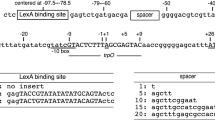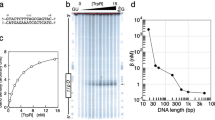Abstract
We constructed mutants of the Trp repressor from Escherichia coli K-12 with all possible single amino acid exchanges at positions 79 and 80 (residues 1 and 2 of the recognition helix). We tested these mutants in vivo by measuring the repression of synthesis of β-galactosidase with symmetric variants of α- and β-centered trp operators, which replace the lac operator in a synthetic lac system. The Trp repressor carrying a substitution of isoleucine 79 by lysine, showed a marked specificity change with respect to base pair 7 of the α-centered trp operator. Gel retardation experiments confirmed this result. Trp repressor mutant IR79 specifically recognizes a trp operator variant with substitutions in positions 7 and 8. Another mutant, with glycine in position 79, exhibited loss of contact at base pair 7. We speculate that the side chain of Ile79 interacts with the AT base pairs 7 and 8 of the α-centered trp operator, possibly with the methyl groups of thymines. Replacement of thymine in position 7 or 8 by uracil confirms the involvement of the methyl group of thymine 8 in repressor binding. Several Trp repressor mutants in position 80 (i.e. AI80, AL80, AM80 and AP80) broaden the specificity of the Trp repressor for α-centered trp operator variants with exchanges in positions 3, 4 and 5.
Similar content being viewed by others
References
Aggerwal AK, Rodgers DW, Drotter M, Ptashne M, Harrison SC (1988) Recognition of a DNA operator by the repressor of phage 434; a view of high resolution. Science 242:899–907
Anderson JE, Ptashne M, Harrison SC (1987) Structure of the repressor-operator complex of bacteriophage 434. Nature 326:846–852
Anderson WF, Ohlendorf DH, Takeda Y, Matthews BW (1981) Structure of the cro repressor from bacteriophage λ and its interaction with DNA. Nature 290:754–758
Arakawa T, Bhat R, Timasheff SN (1990) Why preferential hydration does not always stabilise the native structure of globular proteins. Biochemistry 29:1924–1931
Arrowsmith CH, Carey J, Treat-Clemons L, Jardetzky O (1989) NMR assignments for the amino terminal residues of Trp repressor and their role in DNA binding. Biochemistry 28:3875–3879
Arrowsmith CH, Pachter R, Altmann SB, Iyer B, Jardetzky O (1990) Sequence-specific 1H NMR assignments and secondary structure in solution of Escherichia coli Trp repressor. Biochemistry 29:6332–6341
Bass S, Sorrells V, Youderian P (1988) Mutant Trp repressors with new DNA-binding specifities. Science 242:240–245
Bass S, Sugiono P, Arvidson DN, Gunsalus RP, Youderian P (1987) DNA specifity determinants of Escherichia coli tryptophan repressor binding. Genes Dev 1:565–572
Baumeister R, Helbl V, Hillen W (1992) Contacts between Tet repressor and tet operator revealed by new recognition specifities of single amino acid replacement mutants. J Mol Biol 226:1–14
Bennett GN, Yanofsky C (1978) Sequence analysis of operator constitutive mutants of the tryptophan operon of Escherichia coli. J Mol Biol 121:179–192
Brennan RG (1991) Interactions of the helix-turn-helix binding domain. Curr Opinion Struct Biol 1:80–88
Brennan RG, Matthews BW (1989) The helix-turn-helix DNA binding motif. J Biol Chem 264:1903–1906
Carey J (1988) Gel retardation at low pH resolves Trp repressorDNA complexes for quantitative study. Proc Natl Acad Sci USA 85:975–979
Carey J (1989) Trp repressor arms contribute binding energy without occupying unique locations on DNA. J Biol Chem 264:1941–1945
Carey J, Lewis DEA, Lavoie TA, Yang J (1991) How does Trp repressor bind to its operator. J Biol Chem 266:24509–24513
Devchand RP, McGhee DJ, van de Sande HJ (1993) Uracil-DNA glycosylase as a probe for protein-DNA interactions. Nucleic Acids Res 21:3437–3443
Ebright RH (1991) Identification of amino acid-base pair contacts by genetic methods. Methods Enzymol 208:62a-640
Grove CL, Gunsalus RP (1987) Regulation of the aroH operon of Escherichia coli by the tryptophan repressor. J Bacteriol 169:2158–2164
Haran TE, Joachimiak A, Sigler PB (1992) The DNA target of the Trp repressor. EMBO J 11:3021–3030
Haydock PV, Bogosian G, Brechling K, Sommerville RL (1983) Studies on the interaction of Trp holorepressor with several operators. J Mol Biol 170:1019–1030
Heatwole VM, Somerville RL (1991) The tryptophan specific permease gene, mtr, is differently regulated by the tryptophan and tyrosine repressors in Escherichia coli K-12. J Bacteriol 173:3601–3604
Hurlburt BK, Yanofsky C (1992) The NH2 terminal arms of Trp repressor participate in repressor/operator association. Nucleic Acids Res 20:337–341
Joachimiak A, Haran TE, Sigler PB (1994) Mutagenesis supports water mediated recognition in the trp repressor-operator system. EMBO J 13:367–372
Joachimiak A, Kelly RL, Gunsalus RP, Yanofsky C, Sigler PB (1983) Purification and characterisation of Trp aporepressor. Proc Natl Acad Sci USA 80:668–672
Jordan SR, Pabo CO (1988) Structure of the lambda complex at 2.5 Å resolution: details of the repressor-operator interaction. Science 242:893–907
Kelley RL, Yanofsky C (1985) Mutational studies with the Trp repressor of Escherichia coli support the helix-turn-helix model of repressor recognition helix of operator DNA. Proc Natl Acad Sci USA 82:3120–3124
Klig LS, Carey J, Yanofsky C (1988) Trp repressor interactions with the trp, aroH and trpR operators. J Mol Biol 202:769–777
Kopka ML, Fratini AV, Drew HR, Dickerson RE (1983) Ordered water structure around a B-DNA dodacemer. A quantitative study. J Mol Biol 163:129–146
Kumamoto AA, Miller WG, Gunsalus RP (1987) Escherichia coli tryptophan repressor binds multiple sites within the aroH and trp operators. Genes Dev 1:556–564
Laemmli UK (1970) Cleavage of structural proteins during the assembly of the head of bacteriophage T4. Nature 227:680–685
Lamerichs RMJN, Boelens R, van der Marel G, van Boom JH, Kaptein R (1990) Assignments of the 1H-NMR spectrum of a lac repressor headpiece-operator complex in H2O and identification of NOES: consequences for protein-DNA interaction. Eur J Biochem 194:629–637
Lawson CL, Carey J (1993) Tandem binding of crystals of a trp repressor/operator half-site complex. Nature 366:178–182
Lawson CL, Zhang R-G, Schevitz RQ, Otwinowski Z, Joackimiak A, Sigler PB (1988)Flexibility of the DNA-binding domain of Trp repressor. Proteins 3:18–31
Lehming N, Sartorius J, Niemöller M, Genenger G, von Wilcken-Bergmann B, Müffler-Hill B (1987) The interaction of the recognition helix of Lac repressor with lac operator. EMBO J 6:3141–3153
Lehming N, Sartorius J, Niemöller M, Genenger G, von Wilcken-Bergmann B, Müller-Hill B (1990) Mutant Lac repressor with new specifities hint at rules for protein-DNA recognition. EMBO J 9:615–621
Liu Y-C, Matthews KS (1993) Dependence of trp repressor-operator affinity, stoichiometry, and apparent cooperativity on DNA sequence and size. J Biol Chem 268:23239–23249
Liu Y-C, Matthews KS (1994) Trp repressor mutations alter DNA complex stoichiometry. J Biol Chem 269:1692–1698
Luisi BF, Sigler PB (1990) The stereochemistry and biochemistry of trp repressor-operator complex. Biochim Biophys Acta 1048:113–126
Marmorstein RQ, Sigler PB (1989) Structure and mechanism of the trp repressor/operator system. Nucleic Acids Mol Biol 3:56–78
Marmorstein RQ, Sprinzl M, Sigler PB (1991) An alkaline phosphatase assay to investigate trp repressor/operator interactions. Biochemistry 30:1141–1148
Matthews BW, Ohlendorf DH, Anderson WF, Takeda Y (1982) Structure of the DNA-binding region of Lac repressor inferred from its homology with Cro repressor. Proc Natl Acad Sci USA 79:1428–1432
Miller JH (1972) Experiments in molecular genetics. Cold Spring Harbor Laboratory Press, Cold Spring Harbor, New York
Mondragon A, Harrison SC (1991) The phage 434 cro/OR1 complex at 2.5 Å resolution. J Mol Biol 219:321–334
Mondragon A, Wolberger C, Harrison SC (1989) Structure of phage 434 Cro protein at 2.35 Å resolution. J Mol Biol 205:179–198
Otwinowski Z, Schevitz R-W, Zhang R, Lawson CL, Joachimiak A, Marmorstein RQ, Sigler PB (1988) Crystal structure of Trp repressor/operator complex at atomic resolution. Nature 335:321–329
Pabo CO, Lewis M (1982) The operator-binding domain of λ repressor: structure and DNA recognition. Nature 298:443–447
Pabo CO, Sauer RT (1984) Protein-DNA recognition. Annu Rev Biochem 53:293–321
Pabo CO, Aggerwal AK, Jordan SR, Beamer LJ, Obeysekare UR, Harrison SC (1990) Conserved residues make similar contacts in two repressor-operator complexes. Science 247:1210–1213
Phillips SEV, Manfield I, Parson I, Davidson BE, Rafferty JB, Somers WS, Margarita D, Cohen GN, Saint-Girons I, Stockley PG (1989) Cooperative tandem binding of Met repressor of Escherichia coli. Nature 341:711–715
Phillips SEV, Stockley PG (1994) Similarity of Met and Trp repressors. Nature 368:106
Pu TW, Struhl K (1992) Uracil interference, a rapid and general method for defining protein-DNA interactions involving the 5-methyl group of thymines: the GCN4-DNA complex. Nucleic Acids Res 20:771–775
Risse G, Jooss K, Neuberg M, Brüller H-J, Müffler R (1989) Asymmetrical recognition of the palindromic AP1 binding site (TRE) by Fos protein complexes. EMBO J 8:3825–3832
Rose JK, Squires CL, Yanofsky C, Yang H, Zubay G (1973) Regulation of in vitro transcription of the tryptophan operon by purified RNA polymerase in the presence of partially purified repressor and tryptophan. Nature New Biol 245:133–137
Sambrock J, Fritsch ET, Maniatis T (1989) Molecular cloning: a laboratory manual. Cold Spring Harbor Laboratory Press, Cold Spring Harbor, New York
Sanger F, Nicklen S, Coulson AR (1977) DNA sequencing with chain-terminating inhibitors. Proc Natl Acad Sci USA 74:5463–5467
Sartorius J, Lehming N, Kisters B, von Wilcken-Bergmann B, Müller-Hill B (1989) Lac repressor mutants with double and triple exchanges in the recognition helix bind specifically to lac operator variants with multiple exchanges. EMBO J 8:1265–1270
Sartorius J, Lehming N, Kisters B, von Wilcken-Bergmann B, Müller-Hill B (1991) The roles of residues 5 and 9 of the recognition helix of Lac repressor in lac operator binding. J Mol Biol 218:313–321
Sauer RT, Yocum RR, Doolitille RF, Lewis M, Pabo CO (1982) Homology among DNA-binding proteins suggests use of a conserved super-secondary structure. Nature 298:447–451
Schevitz R-W, Otwinowski Z, Joachimiak A, Lawson CL, Sigler PB (1985) The three dimensional structure of trp repressor. Nature 317:782–786
Sigler PB (1992) In: Transcriptional regulation, vol. 1. Cold Spring Harbor Laboratory Press, Cold Spring Harbor, New York, pp 475–479
Staacke D (1993) PhD thesis, University of Cologne, Germany
Staacke D, Walter B, Kisters-Woike B, von Wilcken-Bergmann B, Müller-Hill B (1990) How Trp repressor binds to its operator. EMBO J 9:1963–1967
Steitz TA, Ohlendorf DH, McKay DB, Anderson WF, Matthews BW (1982) Structural similarity in the DNA-binding domains of catabolite gene activator and cro repressor proteins. Proc Natl Acad Sci USA 79:3097–3100
Wharton RP, Ptashne M (1987) A new specific mutant of 434 repressor that defines an amino acid-base pair contact. Nature 326:888–891
Wolberger C, Dong Y, Ptashne M, Harrison SC (1988) Structure of a phage 434 Cro/DNA complex. Nature 335:789–795
Zurawski G, Gunsalus RP, Brown KD, Yanofsky C (1981) Structure and regulation of aroH, the structural gene for the tryptophan-repressible 3-deoxy-D-arabino-heptulosonic acid-7-phosphate synthetase of Escherichia coli. J Mol Biol 145:47–73
Author information
Authors and Affiliations
Additional information
Communicated by J. Lengeler
Rights and permissions
About this article
Cite this article
Günes, Q., Staacke, D., von Wilcken-Beramann, B. et al. The possible roles of residues 79 and 80 of the Trp repressor from Escherichia coli K-12 in trp operator recognition. Molec. Gen. Genet. 246, 180–195 (1995). https://doi.org/10.1007/BF00294681
Received:
Accepted:
Issue Date:
DOI: https://doi.org/10.1007/BF00294681




